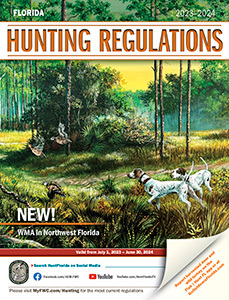Furbearer Regulations
Seasons, dates and bag limits do not apply to wildlife management areas.
Furbearer regulations
- Bobcat and otter may be trapped statewide Dec. 1 – March 1. No bag limits.
- Raccoon, opossum, coyote, beaver, skunk and nutria may be trapped statewide year round. No bag limits.
- Minks, Everglades minks, weasels and round-tailed muskrats cannot be taken or possessed.
License requirements
A furbearer trapping license ($26.50) is required:
- When taking or attempting to take furbearing animals using traps or snares.
- To sell the pelts to licensed fur dealers or meat of furbearing animals, whether taken by trap, snare or gun.
Methods of take
Furbearers may be taken with guns (including air guns), live traps, snares (including power snares) and recorded game calls. Live traps and snares must be checked every 24 hours. Hunting raccoons or opossums at night is allowed, but only .22-caliber rimfire firearms (other than .22-magnums) or single-shot .410-gauge shotguns (using shot not larger than size 6) may be used.
Prohibited
The use of steel leg-hold traps, dog-proof raccoon traps and body-grip (conibear) traps is prohibited, except when permitted by FWC. It is illegal to transport wild-trapped live raccoons within, into or from the state, except by FWC permit or authorization. Hunting raccoons or opossums by displaying or using lights from moving vehicles, vessels or animals is prohibited.
Feeding
The intentional placement of feed or garbage in a manner that is likely to create or creates a public nuisance by attracting foxes, coyotes or raccoons is prohibited.
Closed season on fox
Trapping or shooting foxes is prohibited, but foxes may be chased with dogs year round.
Commercial furbearer requirements
One must possess a fur dealer’s license ($100.00) to buy or sell meat or pelts from furbearing mammals for commercial purposes, or to solicit business by mail or advertising.
CITES tag requirements
Bobcat and otter pelts taken for commercial purposes must be tagged with a CITES tag. Licensed fur dealers and their agents must tag otter and bobcat pelts immediately upon receipt. CITES tags are also required when transporting pelts of bobcat or otter across state lines. The possession of pelts of bobcat and otter is prohibited during the period of April 1 to Nov. 30 unless pelts have been tagged. Tags are distributed to trappers and dealers upon request. To obtain CITES tags, call FWC at 850-488-5878. Fur dealers are held accountable for disposition of tags and are required to return unused tags by April 15.
Falconry
Wildlife management area regulations can differ.
Species |
2023–2024 |
Bag/Possession Limit |
Quail |
Oct. 1 – March 31 |
2/4 |
Gray Squirrel |
Oct. 1 – March 31 |
12/24 |
Rabbit |
Year round |
12/24 |
Extended Falconry - Migratory Game Birds* |
||
Mourning Dove, White-winged Dove |
Feb. 1 – 17 |
3/9** |
Rail (Sora, King, Clapper, Virginia) |
Nov. 10 – Dec. 16 |
|
Common Gallinule (moorhen) |
Nov. 10 – Dec. 13 |
|
Woodcock |
Nov. 24 – Dec. 17 |
|
Feb. 1 – March 9 |
||
Ducks, Light Geese (Snow, Blue and Ross'), Coot |
Nov. 3 – 12 |
|
Feb. 5 – 29 |
||
* Falconers may also hunt during the established seasons for each species listed above, as well as snipe. Daily bag and possession limits of 3 and 9, respectively, apply while hunting migratory game birds with falcons. ** The falconry daily bag limit is 3 migratory game birds singly or in the aggregate. For more information on falconry regulations, contact the FWC's Waterfowl and Small Game Program at 850-488-5878. |
||

